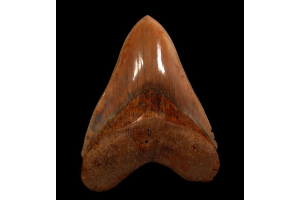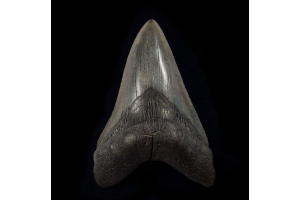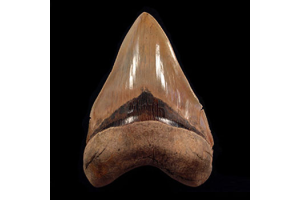Page 6 - Gary Greaser
- - December 04, 2025
Imagine standing by a riverbank or sandy shore, sifting through shells and pebbles when suddenly you spot something large, dark, and triangular. That moment—when your heart races with excitement—is what fossil hunters live for. If you’ve ever dreamed of finding a megalodon tooth, this guide will help you take the first thrilling step toward uncovering prehistoric treasures. At Buried Treasure Fossils, we’re passionate about making fossil discovery fun, educational, and accessible for all curious explorers.
The Ancient Giant of the Sea
Millions of years ago, long before humans roamed the Earth, the oceans were ruled by an enormous predator—the Megalodon. This prehistoric shark could grow up to 60 feet long and had teeth as big as your hand! Each of these teeth tells a story about the ocean world that existed over 3.6 million years ago. Because sharks constantly shed teeth throughout their lives, thousands of fossilized specimens remain buried beneath layers of sediment, waiting to be found.
- - December 04, 2025
Long before humans walked the Earth, colossal predators roamed the oceans—creatures so massive their very presence shaped marine ecosystems. Today, remnants of these giants are found not in the depths of the sea, but in the hands of students, collectors, and educators exploring Earth’s past. Among the most fascinating of these prehistoric relics are megalodon teeth for sale, connecting classrooms and collections around the world to a time when oceans were ruled by a true titan.
The Ocean’s Apex Predator
The Megalodon, whose name means “big tooth,” was not just another prehistoric shark—it was the largest one to ever live. Growing up to 60 feet in length, this ancient predator dwarfed even the great white shark. Its bite force, estimated at up to 180,000 newtons, could crush the bones of whales, its favorite prey. With serrated, triangular teeth measuring over seven inches long, the Megalodon’s jaw could open wide enough to engulf an adult human with ease. These powerful adaptations made
- - December 04, 2025
Long before the beaches of North Carolina became a favorite spot for family vacations, the waters that now surround Ocean Isle were home to some of the most powerful predators the Earth has ever known. These enormous sharks, known as megalodons, once ruled the seas with jaws strong enough to crush whales. Today, their legacy lives on through the fossilized remains of their teeth—some of which have made their way to the surface, sparking fascination for anyone lucky enough to stumble upon them. Among the most thrilling discoveries for fossil hunters is the megalodon tooth in Ocean Isle, a relic that connects our modern world to an ancient oceanic giant.
The Megalodon: Ocean’s Prehistoric Titan
Imagine a shark longer than a school bus with teeth as big as your hand—that was the megalodon. Scientists estimate it lived roughly 23 to 3.6 million years ago during the Miocene and Pliocene epochs. Its name, Carcharocles megalodon, literally means “giant tooth,” and for good reason. These massive
- - December 04, 2025
If you’re searching where to find megalodon teeth in Texas, here’s the short answer: Texas is a fantastic state for Cretaceous shark teeth, but it is not a hotspot for Megalodon. That isn’t bad news, it’s an opportunity to focus your hunt legally and safely, and to build a collection with authentic Megalodon teeth sourced from proven localities worldwide.
What Buried Treasure Fossils Sells
Buried Treasure Fossils specializes in authentic fossil shark teeth (including Megalodon), plus dinosaur fossils and more, serving both collectors and buyers who need quantity (e.g., classrooms, gift shops). The store maintains a dedicated Megalodon catalog with pieces from classic U.S. and international sites and also carries bulk shark teeth for economical purchases.
Why this matters: if your end goal is to own a Megalodon tooth, you don’t have to find it in the field. You can select a verified specimen from Florida, Georgia, the Carolinas, California (Sharktooth Hill), Chile, Peru, and more—precisely
- - December 04, 2025
Long before theme parks and beach vacations, Florida’s warm, shallow seas were home to some of the most fascinating creatures ever to exist—including the mighty Megalodon, the largest shark that ever lived. Today, the Sunshine State remains one of the best places to uncover its ancient secrets. If you’ve ever wondered where to find megalodon teeth in Florida, you’re in luck—Florida’s sandy coasts and riverbeds are full of prehistoric treasures waiting to be discovered.
The Ancient Ocean Beneath Florida’s Feet
Millions of years ago, Florida was completely underwater. The warm coastal seas were teeming with life—giant sharks, whales, sea turtles, and coral reefs filled the ancient ocean. Over time, as sea levels changed and sediments settled, these creatures became buried beneath layers of sand, mud, and limestone. Their bones and teeth turned into fossils, perfectly preserved snapshots of Earth’s distant past.
Because of this unique geological history, Florida’s soil and river systems are
- - December 04, 2025
Collectors and fossil buyers do not look for decorations. They search for authenticity. A real Megalodon tooth stands apart because it holds the raw signature of time. You can feel it in the weight, see it in the enamel, and trace its story through natural wear that no copy can fake. No mold, no paint, and no machine can imitate millions of years beneath the Earth. That is why buying without proof opens the door to disappointment. When you explore genuine megalodon teeth for sale, always focus on proof of origin and condition before you buy. The rise of replicas makes knowledge your best tool. If you want truth in your hands, you must shop with that mindset.
Replicas Hurt More Than Just Value
The problem is not just aesthetics. It is trust. Many sellers post bold claims with no factual background. They offer low-priced fossils that look right in photos but arrive as resin casts. These imitations mislead first-time buyers and frustrate serious collectors. If you invest in fossils without
- - December 04, 2025
At our fossil collection, we take pride in offering specimens that capture the timeless beauty of Earth’s ancient past. Among them, the Otodus megalodon from Indonesia holds a special place. These remarkable fossils have fascinated us with their exceptional preservation, color, and structure.
Each specimen allows us to glimpse into a prehistoric world where colossal predators once ruled the oceans. Their natural artistry and geological perfection make them among the most captivating fossils we offer.
Geological Origin and Preservation
The story of Indonesian Otodus megalodon teeth begins deep within the limestone formations of West Java. These fossils are often recovered from the Bentang Formation, a geological layer that dates to the Middle Miocene epoch, around 10 to 15 million years ago. Within this limestone, the teeth have remained protected for millions of years, allowing them to retain their detailed structure and natural sheen.
Because these fossils were buried under stable
- - November 10, 2025
There’s something extraordinary about holding a piece of ancient history in your hands. Few objects inspire curiosity and wonder like prehistoric shark teeth—especially when they belong to the legendary Otodus megalodon. At Buried Treasure Fossils, we believe these magnificent specimens are more than collector’s items—they’re powerful, hands-on learning tools that ignite scientific curiosity in children and foster a lifelong passion for discovery.
The Fascination of a Prehistoric Giant
The Otodus megalodon—the largest shark to have ever lived—once dominated the oceans over 3 million years ago. This massive predator could grow up to 60 feet long, with jaws strong enough to crush whales. For a young scientist, simply learning about its size and power opens the door to countless questions: How did such an animal evolve? What did it eat? Why did it disappear?
At our store, we’ve seen how even a single fossilized tooth can trigger hours of exploration. It becomes more than just a fossil—it’s
- - November 10, 2025
When powerful coastal storms strike the North Carolina shoreline, they do more than reshape beaches and shift sands. At our fossil collection and research center, we often witness how these natural forces can uncover remarkable fossils that have remained hidden for millions of years.
Among the most impressive of these discoveries are the fossilized teeth of ancient sharks, including the legendary Megalodon Tooth from North Carolina. Through erosion and wave activity, storms can expose deep layers of sediment where these prehistoric treasures lie buried, revealing traces of an oceanic world that once thrived along the coast.
The Geological Setting of North Carolina
The coastline and river systems of North Carolina are known for their fossil-rich formations that continue to yield fascinating discoveries. Several significant geological layers in the region can contain fossil shark teeth from ancient marine environments. These include the Eocene Castle Hayne Formation, the Miocene Pungo
- - November 10, 2025
The ocean has always been a place of mystery, where time seems to stand still and legends often blur with reality. From shimmering coral reefs to the dark trenches of the deep, every current hides a story waiting to be told. Among these stories lies one of the most extraordinary creatures ever to have existed—the Carcharocles megalodon, a name that continues to stir curiosity and wonder among scientists and explorers alike.
The mere idea of this prehistoric predator lurking in unexplored waters sparks imagination. What if, in the remote corners of our planet’s vast ocean, traces of the ancient giant still remain?
Tracing the Shadows of a Giant
New Caledonia, surrounded by the South Pacific’s brilliant blues and hidden depths, offers a unique geological setting for fossil discoveries. Beneath its calm lagoons and sharp coral ridges lie sedimentary layers that have preserved fragments of Earth’s ancient marine history. Fossilized teeth found in similar regions give us an idea of the megalodon’s







